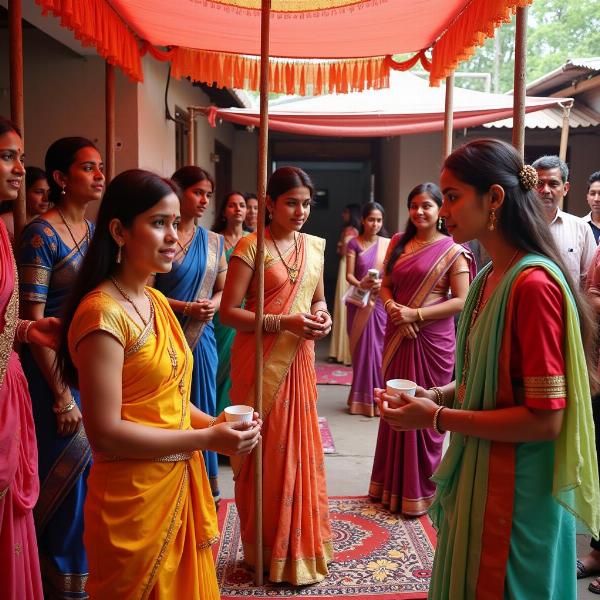Puberty ceremony meaning in Hindi encompasses a rich tapestry of traditions and rituals that mark a significant transition in an individual’s life. Understanding the puberty ceremony meaning in Hindi requires delving into the cultural nuances, religious beliefs, and social significance attached to this milestone, particularly within the Indian context. This article explores the various aspects of these ceremonies, shedding light on their historical context, regional variations, and the evolving perspectives surrounding them.
Understanding the Significance of Puberty Ceremonies in India
Puberty marks the transition from childhood to adolescence, a period of significant physical and emotional changes. In India, this transformation is often celebrated through elaborate ceremonies that vary across different regions and communities. These rituals serve not only to acknowledge the biological changes but also to integrate the individual into the larger social fabric as a responsible member of society. The ceremonies often involve prayers, blessings, gifts, and community feasts, symbolizing the individual’s readiness for adulthood and the responsibilities that come with it.
Regional Variations in Puberty Rituals
While the core essence of puberty ceremonies remains consistent – acknowledging the transition to adulthood – the specific rituals and customs differ significantly across India’s diverse landscape. In South India, for example, the Sadangu ceremony is a prominent ritual for Brahmin girls, marking their first menstruation. In other regions, different ceremonies exist with varying names and practices. These variations reflect the unique cultural tapestry of India and the localized interpretations of this significant life event.
The Religious and Spiritual Underpinnings
Puberty ceremonies in India are often deeply rooted in religious and spiritual beliefs. They are seen as a way to seek blessings from deities for a healthy and prosperous future. Many rituals involve prayers, offerings, and purification ceremonies, signifying a spiritual cleansing and preparation for the responsibilities of adulthood. These ceremonies underscore the interconnectedness of physical, emotional, and spiritual growth in Indian culture.
Evolving Perspectives on Puberty Ceremonies in Modern India
While traditional practices continue to hold significance, perspectives on puberty ceremonies are evolving in modern India. With increasing awareness of reproductive health and changing social norms, conversations around menstruation and puberty are becoming more open. There’s a growing emphasis on educating young people about these changes in a scientific and factual manner, alongside the cultural and religious significance.
What is the typical age for puberty ceremonies in India?
The age for puberty ceremonies typically coincides with the onset of menstruation for girls, usually between 11 and 16 years old. For boys, the age can vary depending on the specific tradition and community.
Are puberty ceremonies only for girls?
While puberty ceremonies are more commonly associated with girls, some communities also have rituals for boys, although they are often less elaborate.
 Modern Puberty Ceremony in India
Modern Puberty Ceremony in India
Conclusion: Celebrating a Rite of Passage
Puberty ceremonies in India, rich in tradition and cultural significance, mark a crucial transition in an individual’s life. These ceremonies, while varying across regions and religions, underscore the importance of acknowledging and celebrating the journey to adulthood. As India continues to evolve, so too will the interpretations and practices surrounding puberty ceremonies, adapting to modern sensibilities while preserving the core values of community, family, and spiritual growth. Understanding the puberty ceremony meaning in Hindi allows us to appreciate the intricate tapestry of Indian culture and its enduring celebration of life’s milestones.
FAQ:
- What is the main purpose of a puberty ceremony? The primary purpose is to acknowledge and celebrate the transition from childhood to adolescence, marking the individual’s entry into adulthood.
- Are puberty ceremonies mandatory in India? While traditionally significant, they are not legally mandatory. Participation is based on family and community customs.
- What are some common gifts given during these ceremonies? Common gifts include new clothes, jewelry, and blessings from elders.
- Do puberty ceremonies differ between urban and rural areas? While core elements remain, urban ceremonies might incorporate modern elements, while rural areas often adhere to more traditional practices.
- How long does a typical puberty ceremony last? The duration varies from a few hours to several days, depending on the specific customs and rituals.
- Are there any specific dietary restrictions during these ceremonies? Dietary restrictions might apply based on the specific religious and cultural practices of the community.
- What is the significance of the gifts given during puberty ceremonies? Gifts symbolize blessings and wishes for a prosperous future for the individual entering adulthood.
About Meaning-Hindi.in
Meaning-Hindi.in is your trusted partner for professional Hindi translation services. We offer a wide range of services, including business and commercial document translation, certified and legal document translation, technical and user manual translation, website localization, educational and academic document translation, express translation, and specialized translation services. Our expertise in language and cultural nuances ensures accurate and culturally sensitive translations, bridging the communication gap between Hindi and other languages. For all your translation needs, contact us at [email protected] or call us at +91 11-4502-7584. Let Meaning-Hindi.in be your language solution provider.